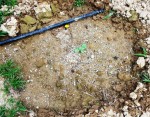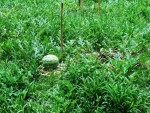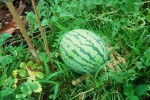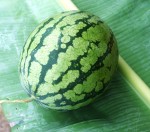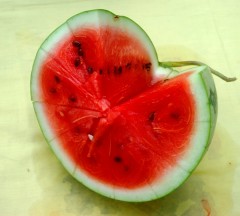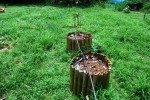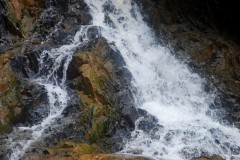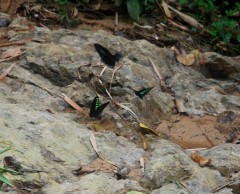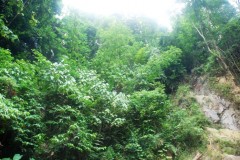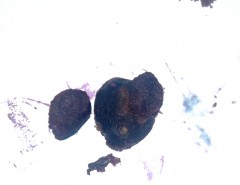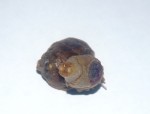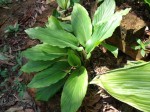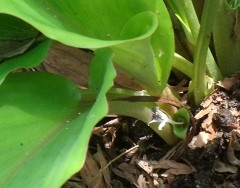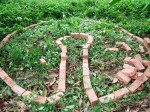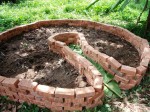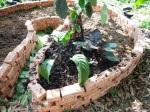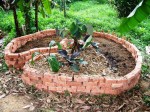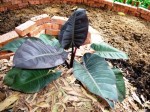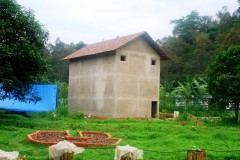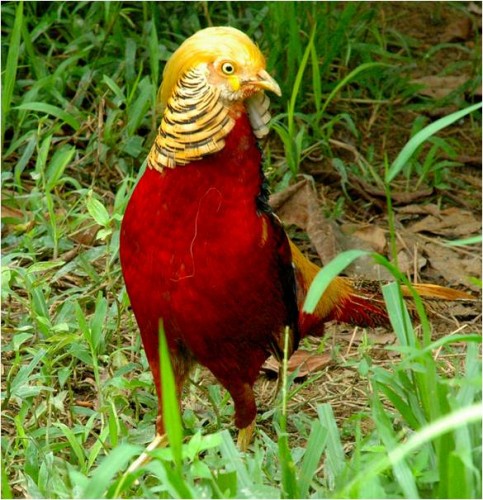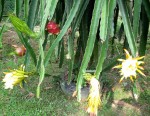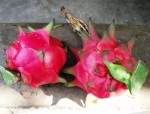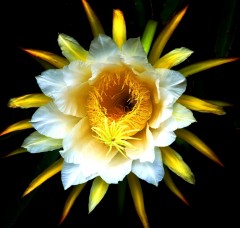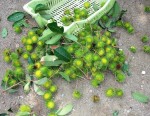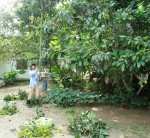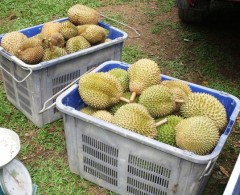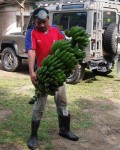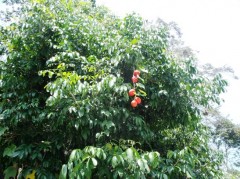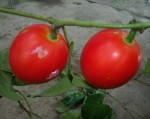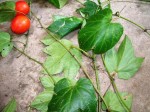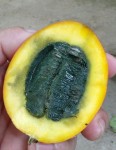Sep 30, 2009
Organic Watermelons Anyone?
I love watermelons and just cannot find organic ones.
So we decided to grow our own.
Watermelons need sandy soil and plenty of water.
Watermelons on the way.
Almost ready for harvest. So far, no loss to insects and disease due to our sprays of Teh Qi and herbs.
Our first watermelon
Beautiful color and juicy; shared by Alternative Mom and her family with us.
Next, watermelon on raised beds:
If successful, we will go commercial as the market have very little and inconsistent supply of organic watermelons.
18:12 Posted in Blog | Permalink | Comments (0) | Tags: watermelons, raised beds, organic watermelon
Sep 14, 2009
Amongst the Raja Brooke's Birdwings
Did two hours of taichi and qi gong at this small cascading stream near the farm yesterday. The place was deserted.
Click on pictures to enlarge
A group of about ten Raja Brooke's Birdwings came to join me, fluttering around me with no fear.
And a pair of pretty yellow-green butterflies.
It doesn't get much better than this.
This morning my BP was 115 / 68; like new. And that crick in the knee was gone.
Have to make it a habit to do the exercises here, each week; amongst the Raja Brooke's Birdwings
20:51 Posted in Blog | Permalink | Comments (0) | Tags: raja brooke's, birdwing butterflies, qi gong, tai chi
Sep 09, 2009
Black Curcuma / Black Turmeric
We have this very delicate small curcuma (barely a foot tall) that produces a completely black rhizome.
It is clearly not temu hitam or curcuma aeruginosa roxb. The temu hitam plant is larger, more robust and the rhizome is only slightly bluish. The leaves of the temu hitam have a purplish spine and the flower is reddish, pinkish.
Click for close up
The completely black / deep purple rhizome.
Click for close up
The rhizome before removing the thin skin.
It does not seem to be curcuma caesia or Kali Haldi (click on word for wiki article) which looks like curcuma aeruginosa.
Click for close-up
Anybody knows the scientific name for this curcuma? I have not been able to find any reference to it.
NOTE 22/7/2012 : TWO READERS OF THIS BLOG, ONE FROM HAWAII, AND ANOTHER FROM LANGKAWI, PAK DIN, http://herbwalk-langkawi.com.my/thewalk.html HAVE IDENTIFIED THIS PLANT AS Kaempferia parviflora, A PLANT FOUND IN NORTHERN THAILAND AND USED EXTENSIVELY FOR TRADITIONAL MEDICINE. THANKS TO BOTH FOR HELPING OUT.
THE PLANT WAS FOUND IN A FOREST NEXT TO OUR FARM. WE TAKE NOTE THAT THE FOREST IN QUESTION IS BOUNDED ON THREE SIDES BY FARMS AND ON ONE SIDE BY A FOREST RESERVE. WE CAN ONLY SPECULATE HOW IT WAS INTRODUCED INTO THE FOREST, THOUGH WE MUST ADMIT IT SEEMS EXTREMELY WELL ADAPTED TO THE CONDITIONS LOCALLY AND WE HAVE NEVER SEEN ANY DISEASE AFFECTING THE SAID PLANT.
15:18 Posted in Blog | Permalink | Comments (8) | Tags: black turmeric, kunyit hitam, temu hitam, kali haldi, curcuma aeruginosa, curcuma caesia
Aug 29, 2009
The Tree
Tok Guru on tree planting and the act of Ibadah:
00:36 Posted in Blog | Permalink | Comments (0) | Tags: tok guru, ibadah
Aug 23, 2009
Preventive Measures for Flu - Revisited
In 2005 we posted on preventive measures one can take against Avian Flu. The strategies are still valid against A(H1N1). To read the post, click here:
http://dqfarm.blogspirit.com/archive/2005/09/26/preventiv... .
We no longer teach Qi Gong (one of the strategies), so if you are keen, you can join a local class in your neighbourhood.
Also, there have been numerous reports that TCM (Traditional Chinese Medicine) preparations for flu are effective against A(H1N1). Visit a reputable centre such as Tung Shin.
09:13 Posted in Blog | Permalink | Comments (0) | Tags: h1n1, flu prevention
Aug 21, 2009
A Spot Of Darkness
I have this thing about Darkness. So we decided to build a spot of darkness in a corner of the farm; a spot dedicated to dark colored plants. Plants with dark leaves, dark flowers, dark tubers.
The plants will be grown in a raised bed with a Permaculture key-hole design.
Lay out the design with the key-hole (used for walking when tending the garden)
Build up the wall; how high depends on how deep-rooted the plants are. (These are left-over clay bricks from the walit house).
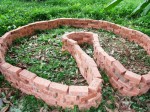
Put in the planting material; here, dead leaves, some very old broken down chicken manure, some soil etc.
Then add in the compost and the plants.
Then mulch it.
Here we have only completed planting just one corner while we hunt for more dark plants. We planted some aroids from the jungle, such as this (haven't got the name yet. Click for close-up). :
And a Tacca Chantrieri from the jungle, which flower is black (Click on photo for close-up) :
Photo of the Tacca flower from here
Once the garden is matured, perhaps we can sip dark pu erh tea and savour it with a melancholic Stratovarius playing in the background.
12:04 Posted in Blog | Permalink | Comments (0) | Tags: raised beds, key hole garden, permaculture, dark colored plants.
Aug 10, 2009
Caviar of the East - Edible Bird's Nest
The swiftlets of the species, Aerodramus fuciphagus and Aerodramus maximus produce edible nests called the caviar of the East, primarily because of the high price.
The swiftlets come down from the forest reserve adjoining our farm to feast on the many insects that the farm is home to. We are building a 3 storey building for the birds to harvest their nests in a sustainable manner.
Barely three weeks after we started work, the building is now on its final third level. And today while the outside temperature was hovering between 30 to 34 celcius, the inside was a constant 24 celcius, the ideal temperature for the birds. The wonders modern construction methods can do!
The key to successful swiftlet rearing is stability of temperature throughout the day and night. We are off to a good start.
The last floor. Click on pic for a close-up look.
Update September 13th, 2009 :
click to enlarge
September 13th, almost there. The fasting month has delayed things somewhat as some of the workers went back to their home villages. Hopefully, after Hari Raya Aidilfitri we can start calling the birds to come to their new home.
10:54 Posted in Blog | Permalink | Comments (2) | Tags: walit, swiftlets, aerodramus fuciphagus, aerodramus maximus
Jul 24, 2009
Birds at the Farm
The farm at one time was a zoo of exotic birds. We developed all black cemani type chickens, hybrids between guinea fowl and chickens, chickens that weigh in at less than 250 grams fully grown and various other exotics. Visit the album of some of the birds by clicking the link below. We will add as we go along.
http://dqfarm.blogspirit.com/album/birds-at-the-farm/
14:57 Posted in Blog | Permalink | Comments (0)
Jul 16, 2009
Fruiting Season...
It's fruiting season and here are some of the fruits:
Dragon fruit plant and the fruits.
Here's a macro close-up of the flower (click for enlarged photo) :
While half of the pitaya farms in Malaysia are decimated by a fungal problem, ours are free from disease with regular spraying of Teh Qi.
All manners of hard-to-find Musa varieties.
Other fruits ripening include mangosteen, nangka and cempedak.
We estimate our production this year to be 50 metric tonnes, all grown with our own farm-made compost.
17:00 Posted in Blog | Permalink | Comments (2) | Tags: dragon fruit, jackfruit, cempadak, durians
Jul 01, 2009
What's This Fruit? Looks like a passiflora.
Saw this fruit hanging from a wild vine. Never seen it before. Anybody have any idea what it is? Looks like a passiflora. Any ideas?
20:48 Posted in Blog | Permalink | Comments (0)








